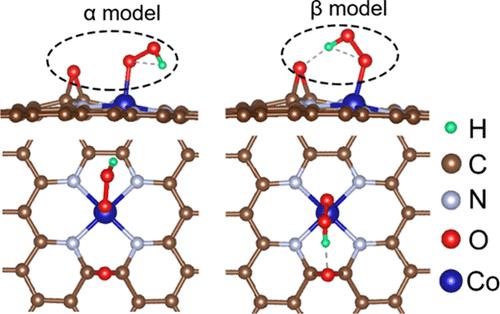环氧化单原子 Co-N-C 催化剂通过双电子途径促进氧还原反应
IF 8.2
2区 材料科学
Q1 MATERIALS SCIENCE, MULTIDISCIPLINARY
引用次数: 0
摘要
单原子催化剂的配位结构和基团修饰对于调节表面电子结构和反应活性至关重要。环氧基团修饰的单原子 Co-N-C 构型在过氧化氢生产中表现出卓越的催化性能。通过操纵 Co-N-C 的配位结构和掺杂的环氧基团,我们阐明了环氧基团修饰的 Co-N-C 构型催化活性的来源。理论结果表明,Co-N-C 结构的第二个配位球对于环氧基团作为协同催化剂调节双电子途径至关重要。这种协同催化机制源于环氧基团和 OOH 中间体之间的氢键相互作用。在 Co-N-C 构型的第二个配位层中有三个环氧基团,从而实现了产生过氧化氢的最佳 G*OOH(4.22 eV)。这项研究为过氧化氢电合成催化材料的设计及其表面结构工程提供了新的见解。本文章由计算机程序翻译,如有差异,请以英文原文为准。

Epoxidized Single-Atom Co–N–C Catalysts Promote the Oxygen Reduction Reaction via a Two-Electron Pathway
Coordination structure and group modifications of single-atom catalysts are essential for regulating superficial electronic structures and reaction activities. Epoxy group-modified single-atom Co–N–C configuration demonstrates exceptional catalytic performance for hydrogen peroxide production. Through the manipulation of the coordination structure of Co–N–C and the doped epoxy groups, we elucidate the origin of catalytic activity in epoxygroup-modified Co–N–C configurations. Theoretical results indicate that the second coordination sphere of the Co–N–C structure is essential for the regulation of the two-electron pathway by the epoxy groups acting as cocatalysts. This cocatalytic mechanism originates from hydrogen bonding interactions between the epoxy groups and the OOH intermediates. Three epoxy groups within the second coordination sphere of Co–N–C configuration lead to the achievement of the optimal G*OOH (∼4.22 eV) for hydrogen peroxide production. This study offers novel insights into the design of catalytic materials for the electrosynthesis of hydrogen peroxide as well as the engineering of their surface structures.
求助全文
通过发布文献求助,成功后即可免费获取论文全文。
去求助
来源期刊

ACS Applied Materials & Interfaces
工程技术-材料科学:综合
CiteScore
16.00
自引率
6.30%
发文量
4978
审稿时长
1.8 months
期刊介绍:
ACS Applied Materials & Interfaces is a leading interdisciplinary journal that brings together chemists, engineers, physicists, and biologists to explore the development and utilization of newly-discovered materials and interfacial processes for specific applications. Our journal has experienced remarkable growth since its establishment in 2009, both in terms of the number of articles published and the impact of the research showcased. We are proud to foster a truly global community, with the majority of published articles originating from outside the United States, reflecting the rapid growth of applied research worldwide.
 求助内容:
求助内容: 应助结果提醒方式:
应助结果提醒方式:


